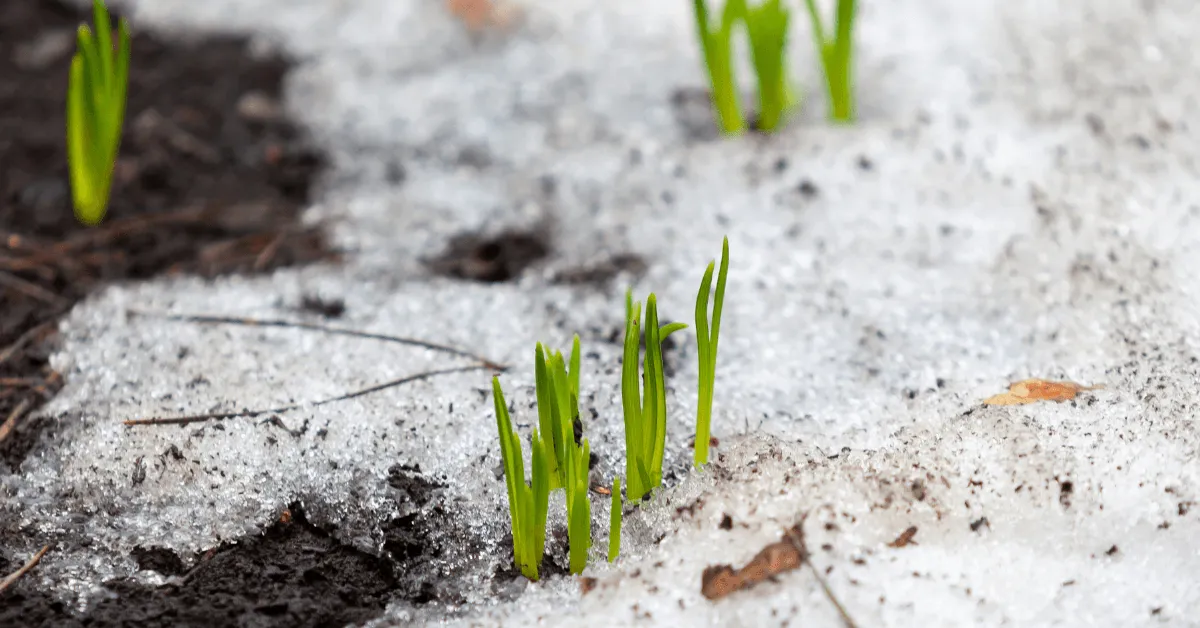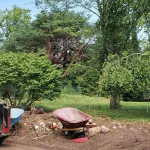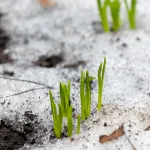
November 10, 2025
When winter arrives, snow and ice can transform your landscape into a beautiful scene, but they can also be hard on your trees. Heavy snow, freezing rain, and sudden temperature drops can cause broken limbs, split bark, and lasting stress that weakens trees over time.
At Crawford Tree & Landscape, we help homeowners protect their trees before the first freeze. Proper winter preparation keeps trees strong, reduces damage, and ensures they thrive when spring returns. This guide explains how to prepare your trees for snow and ice and why early action makes all the difference.
Schedule your pre-winter tree inspection with Crawford Tree & Landscape before the first snow.
The Importance of Winter Tree Protection
Winter weather is one of the top causes of structural tree damage in the Midwest and northern regions of the United States. Snow and ice can snap branches, freeze roots, and put stress on even the healthiest trees.
Common winter damage includes:
- Broken limbs caused by the weight of snow or ice
- Frost cracks from rapid temperature changes
- Winter burn occurs when cold winds draw moisture from leaves or needles
- Root damage from frozen or compacted soil
- Animal damage from deer, rabbits, and rodents searching for food
Protecting your trees before harsh weather arrives is not only about preserving beauty. It is about maintaining safety, preventing property damage, and protecting your landscape investment.
What Arborists Look for During a Winter Tree Check
Your first step in winter tree preparation should be a professional inspection. A certified arborist from Crawford Tree & Landscape can identify weaknesses and risks that most homeowners cannot see.
Look for these warning signs:
- Dead or cracked limbs
- Weak branch unions shaped like a tight “V”
- Cavities or decay in the trunk
- Exposed or damaged roots
- Signs of insects or disease
Fixing these issues early helps prevent dangerous branch failures and emergency tree removals after a storm.
Expert tip: Book your inspection in late fall, after leaves drop but before the ground freezes. This timing gives arborists a clear view of the tree’s structure.
Best Time of Year to Prune for Winter Protection
Pruning is one of the most effective ways to protect trees from snow and ice. Removing weak or overgrown branches helps reduce the surface area that collects snow, lowering the chance of breakage.
At Crawford Tree & Landscape, we follow pruning standards to ensure each cut supports long-term tree health. Our team focuses on:
- Thinning dense canopies so snow can fall through
- Removing dead, diseased, or rubbing branches
- Shortening long, heavy limbs that may bend under snow weight
The best time to prune most trees is late fall through early winter while they are dormant. This reduces sap loss and disease risk while allowing trees to heal naturally before spring growth begins.
How to Apply Mulch the Right Way
Tree roots need insulation during cold months. Applying a 2 to 4-inch layer of organic mulch around the base helps keep soil temperatures steady and prevents moisture loss.
Spread mulch under the tree’s drip line, but keep it a few inches away from the trunk to prevent rot. Use shredded bark, wood chips, or composted leaves for the best results.
Mulching also helps reduce frost penetration and soil heaving, which can expose roots to freezing air.
Trees That Benefit Most from Winter Wrapping
Rapid changes between warm daytime temperatures and freezing nights can cause bark to split, a problem known as sunscald or frost cracking.
To protect your trees, wrap the trunks of young or thin-barked species such as maples, birches, and fruit trees with commercial tree wrap or white paper guards.
Start at the base and wrap upward to the first set of branches, overlapping each layer slightly. Remove the wrap in early spring to allow air circulation and prevent moisture buildup.
Safer Alternatives to Rock Salt
Deicing salt keeps driveways and sidewalks safe, but it can harm nearby trees. Sodium chloride draws moisture out of soil and roots, leading to dehydration and dieback.
To protect your landscape:
- Use calcium magnesium acetate (CMA) or sand instead of rock salt.
- Create burlap barriers or snow fences between roadways and trees.
- In early spring, flush the soil around salt-exposed areas with water to wash away residue.
Avoid piling salty snow around tree bases or root zones, since salt can remain in the soil long after the snow melts.
Simple Steps to Keep Evergreens Hydrated
Evergreen trees and shrubs, including pines, spruces, and boxwoods, are at high risk for winter burn because they lose water through their needles year-round. When the ground freezes and roots cannot absorb moisture, foliage turns brown or yellow.
To prevent this:
- Water deeply in late fall before the ground freezes.
- Apply mulch to retain soil moisture.
- Use anti-desiccant sprays to reduce water loss from needles.
- Set up burlap windbreaks around exposed evergreens to block cold, dry winds.
These steps keep evergreens hydrated and vibrant through the coldest months.
What Not to Do When Trees Are Ice-Covered
Removing snow and ice from trees requires patience and care. Done incorrectly, it can cause more harm than good.
Follow these best practices:
- For light snow, gently brush branches upward with a broom.
- For heavy snow, allow it to melt naturally. Knocking snow off can cause limbs to snap.
- For ice, never try to break it loose. Wait until it thaws or contact a professional arborist.
If branches break under the weight of snow or ice, call Crawford Tree & Landscape immediately. Prompt, proper pruning can prevent further damage and disease.
Protect Trees from Wildlife and Rodents
During winter, wildlife often feed on bark, twigs, and buds when other food sources run out. Deer, rabbits, and voles can cause serious bark damage, especially on young trees.
Protect trunks by installing plastic tree guards or hardware cloth that extends two to three feet above the ground and a few inches below the soil.
For large properties, repellents and fencing can also help keep deer away from vulnerable trees and shrubs.
Schedule Regular Tree Maintenance
The best defense against winter damage is consistent tree care throughout the year. Trees that receive proper pruning, watering, and soil management are naturally stronger and more resilient.
Partnering with Crawford Tree & Landscape gives you access to certified arborists who understand local weather conditions and tree species. Our comprehensive tree care services include:
- Preventive pruning and inspection
- Structural bracing and cabling
- Storm damage prevention and cleanup
- Tree health monitoring and disease management
We take a proactive approach to help your trees stay safe before, during, and after the winter season.
Debunking Common Winter Tree Myths
- Myth 1: Trees do not need water in winter.
False. Trees continue to lose moisture through their roots and bark, especially during dry winters. Deep watering before the ground freezes helps prevent dehydration. - Myth 2: Pruning should always wait until spring.
Incorrect. Dormant-season pruning is often better for the tree because it reduces stress and the spread of disease. - Myth 3: Evergreens are immune to winter damage.
Not true. Evergreens can suffer from winter burn and broken branches just like deciduous trees.
Why You Should Trust Experts for Winter Tree Protection
While homeowners can handle basic tasks such as mulching and wrapping, some work requires a trained eye and specialized equipment. Professional arborists know how to balance safety, structure, and growth to ensure trees stay healthy for years to come.
At Crawford Tree & Landscape, we combine scientific arboriculture with decades of local experience. Our team is fully licensed and insured, and we follow the industry’s highest standards for safety and care. Whether you need pre-winter pruning, emergency cleanup, or full seasonal maintenance, we are ready to help.
Essential Winter Tree Care Checklist
| Task | Best Time | Purpose |
| Professional inspection | Late fall | Identify weak branches and hazards |
| Pruning | Before heavy snow | Reduce breakage risk |
| Mulching | Late fall | Insulate roots and maintain moisture |
| Wrapping trunks | Before freezing | Prevent frost cracks |
| Watering | Before the ground freezes | Protect from dehydration |
| Wind and salt protection | Winter | Prevent winter burn |
| Wildlife control | Late fall | Protect the bark from damage |
| Expert maintenance | Year-round | Maintain long-term tree health |
Frequently Asked Questions About Winter Tree Protection
1. When should I start preparing my trees for winter?
Start your winter tree preparation in late fall, after leaves have dropped but before the ground freezes. This allows time for pruning, inspections, and mulching while trees are dormant and less vulnerable to stress.
2. How can I protect my trees from snow and ice damage?
Prune weak or overextended branches, apply mulch around the base, and wrap young or thin-barked trunks. For multi-stemmed trees, consider cabling or bracing. Avoid shaking snow or ice from branches; instead, let it melt naturally or call a professional arborist.
3. Should I water my trees during winter?
Yes. Give your trees a deep watering before the ground freezes to prevent winter dehydration. In mild winters, water during dry spells when the soil is not frozen to maintain root health.
4. Can road salt harm my trees?
Yes. Salt used for melting snow can dehydrate roots and damage soil. Use calcium magnesium acetate (CMA) or sand instead, and build barriers to keep salt away from tree bases. In spring, flush the soil with water to reduce salt buildup.
5. Do evergreens need protection from cold weather?
They do. Evergreens can suffer from winter burn when cold winds draw moisture from needles. Protect them with burlap windbreaks, anti-desiccant sprays, and a thick layer of mulch to retain soil moisture.
6. Why should I hire a professional tree service for winter prep?
A certified tree service company like Crawford Tree & Landscape can spot hidden structural weaknesses, prune safely, and install supports without damaging the tree. Professional winter prep ensures your trees remain healthy, stable, and ready for spring growth.
Why Milwaukee-Area Trees Need Specialized Care
Trees in your area face unique challenges from snow load, freezing rain, and fluctuating temperatures. The experts at Crawford Tree & Landscape know what works best for the local climate and soil conditions.
Our goal is to keep your property safe, beautiful, and healthy all year long. By scheduling your winter tree prep service before the first snow, you give your landscape the best chance to thrive through even the harshest conditions.
Call Crawford Tree & Landscape today at (414) 710-0093 to schedule an inspection.







 GreenSky® and GreenSky Patient Solutions® are loan program names for certain consumer credit plans extended by participating lenders to borrowers for the purchase of goods and/or services from participating merchants/providers. Participating lenders are federally insured, federal and state chartered financial institutions providing credit without regart to age, race, color, religion, national origin, gener or familial status. GreenSky® and GreenSky Patient Solutions® are registered trademarks of GreenSky, LLC. GreenSky Serviceing, LLC services the loans on behalf of participating lenders. NMLS 1416362. GreenSky, LLC and GreenSky Servicing, LLC are subsidiaries of Goldman Sachs Bank USA. Loans originated by Goldman Sachs are issued by Goldman Sachs Bank USA, Salt Lake City Branch.
GreenSky® and GreenSky Patient Solutions® are loan program names for certain consumer credit plans extended by participating lenders to borrowers for the purchase of goods and/or services from participating merchants/providers. Participating lenders are federally insured, federal and state chartered financial institutions providing credit without regart to age, race, color, religion, national origin, gener or familial status. GreenSky® and GreenSky Patient Solutions® are registered trademarks of GreenSky, LLC. GreenSky Serviceing, LLC services the loans on behalf of participating lenders. NMLS 1416362. GreenSky, LLC and GreenSky Servicing, LLC are subsidiaries of Goldman Sachs Bank USA. Loans originated by Goldman Sachs are issued by Goldman Sachs Bank USA, Salt Lake City Branch.





